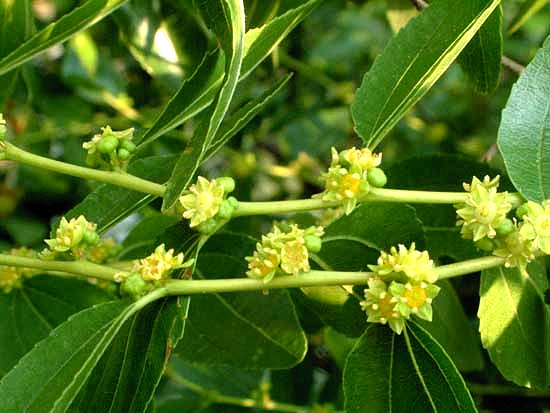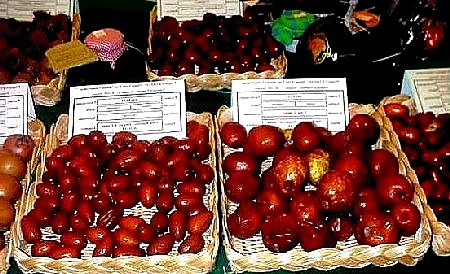Lessico
Giuggiolo
o zizzolo
Zizyphus sativa

In latino zizyphus, dal greco zízyphon. Nome di alcune specie di piante legnose del genere Zizyphus - famiglia Ramnacee - e in particolare di Zizyphus sativa, detta anche zizzolo, spontanea in Asia dal Mediterraneo orientale alla Cina, coltivata e inselvatichita nelle regioni calde d'Italia. È un alberetto con rametti gracili e angolosi, dalle foglie lucide, ristrette all'apice, appena seghettate, con fiori giallicci a forma di stella, che producono frutti brunicci (giuggiole), simili a piccoli datteri, molto dolci, consumati crudi o usati per farne canditi o marmellate. Non possiede costituenti strani: zuccheri – saccarosio, glucosio - e mucillagini. La sua azione fondamentale è quella di essere nutriente ed emolliente.

Secondo la
medicina tradizionale cinese è energetico, spesso usato col ginseng, la
pianta-uomo, Panax ginseng della famiglia Araliacee. Se il giuggiolo è
energetico, potrebbe favorire l’attività sessuale, ammesso che l’aluiule
di Razi![]() corrisponda al giuggiolo.
corrisponda al giuggiolo.
Anni addietro, intorno al 1993, con il defunto collega Dr Giancarlo Baratti, ero giunto alla conclusione che l’espressione andare in brodo di giuggiole dovrebbe dipendere dal fatto che questi frutti sono molto dolci, il che non era specificato nel Dizionario etimologico della lingua italiana di Cortelazzo-Zolli, dove si riporta solamente il significato: ‘gongolare di gioia’ (1791, D. L. Batacchi).
Per ampliare e completare i dati, riportiamo uno stralcio di ciò che si può reperire nel web a proposito del giuggiolo.
|
Botanical.com Jujube
Berries Botanical:
Zizyphus vulgaris (lamk.) Family:
N.O. Rhamnaceae ---Synonyms---Zizyphus
sativa. Brustbeeren. Judendornbeeren. Rhamnus Zizyphus. ---Part
Used---Fruit. ---Habitat---Southern
Europe. ---Habitat---Originally a native of Syria, Zizyphus vulgaris was introduced into Italy in the reign of Augustus, and is now naturalized in Provence, and particularly in the islands of Hyères, where the berries are largely collected when ripe, and dried in the sun.
The
trees average 25 feet in height and are covered with a rough, brown
bark. They have many branches, with annual thorny branchlets bearing
alternate, oval-oblong leaves of a clear green colour, with three to
five strongly-marked, longitudinous veins. The small flowers are pale
yellow and solitary. The fruit is a blood-red drupe, the size and
shape of an olive, sweet, and mucilaginous in taste, slightly
astringent. The pulp becomes softer and sweeter in drying, and the
taste more like wine. They have pointed, oblong stones. ---Constituents---A
full analysis has not yet been made, but the berries are valued for
their mucilage and sugar. ---Medicinal
Action and Uses---The Jujube is classed with the raisin, date, and fig
as a pectoral fruit, being nutritive and demulcent. It is eaten both
fresh and dried. A
syrup and a tisane were formerly made from it, but the berries
are now little used in medicine. Jujube
paste, or 'Pâte de Jujubes,' is made of gum-arabic and sugar. It may
be dissolved in a decoction of jujubes and evaporated, but is
considered as good a demulcentwithout their addition. It is frequently
merely mixed with orange-flower water. A
decoction of the roots has been used in fevers. An
astringent decoction of leaves and branchlets is made in large
quantities in Algeria, and seems likely to replace the cachou. ---Other
Species--- Z.
Lotos,
sometimes also called Z. sativa, of Northern Africa and Z.
Jujuba of the East Indies possess similar properties, and are used
in their respective countries. Z. Lotos is thought to have been
one of the sources of the famous sweet fruits from which the ancient
Lotophagi took their name, the liqueur prepared from which caused
those who partook of it to forget even their native countries in its
enjoyment. The Arabs call it Seedra. In Arabia a kind of bread
is made of them by exposing them to the sun for a few days
and then pounding them in a wooden mortar to separate the stones. The
meal is mixed with water and formed into cakes which after drying in
the sun resemble sweet gingerbread. Z.
Baclei
is said to be used in the same way
in Africa, and also for making a beverage. Z.
Jujuba
is largely cultivated by the
Chinese, in many varieties as a dessert fruit, some being called
Chinese Dates, and it is also one
of the main sources of stick-lac. Z.
Cenoplia
of India has edible
fruits, and the bark is esteemed as a vulnerary. In
Cochin-China the berries
of Z. agrestis are eaten. In
Senegal the fruits of Z.
Barelei are slightly styptic, and the negroes use the roots for
gonorrhoea. It is probably the same species
that is used there in venereal diseases. A
decoction of the dried
leaves of Z. Napeca is said to be used for washing ulcers in
Arabia. Z.
spina Christi, or Rhamnus spina Christi, of Ethiopia, is said to be the source of the crown of thorns placed on the Saviour's head. The Arabs call it Nabka. Puretango.com
Jujube is a very commonly used herb, especially in formulas that use
Ginseng. The date is believed to enhance the activity of Ginseng while
smoothing out any rough edges the Ginseng may have. It harmonizes the
ingredients in an herbal formula, making the whole formula smooth in
both taste and action. However, because it benefits digestion and
absorption, it helps the body use nourishing foods to create strength
and energy. Traditional Chinese Medicine -
This special fruit, sometimes called the "red date," has
been used since ancient times as a nutrient tonic, a blood cleanser,
and as an important adjunctive herb to other tonics, especially in
combination with Ginseng. Jujube, is universally believed in the Asia
to build strength and extend life. Jujube is slightly sedative and
laxative and removes obstructions of the energy flow. In combination
with Ginseng, Jujube nourishes the spirit, acting to soothe
irritability and mild emotional instability. Constituents - Vitamin
A, Vitamin B2, Vitamin C, calcium, phosphorous, oleanolic acid,
oleanonic acid, jujuboside b, rutin, scopoletin. |
